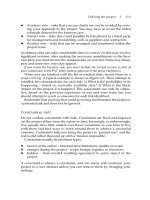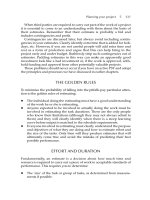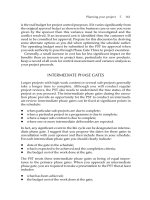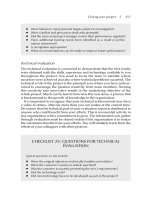Management a practical introduction 3rd kinicky chapter 02
Bạn đang xem bản rút gọn của tài liệu. Xem và tải ngay bản đầy đủ của tài liệu tại đây (487.97 KB, 49 trang )
Management
A Practical Introduction
Third Edition
Angelo Kinicki &
Brian K. Williams
Kinicki/Williams, Management: A Practical Introduction 3e ©2008, McGraw-Hill/Irwin
Chapter 2: Management Theory
Essential Background For
Managers
How We Got To Where We Are Today
Classical Viewpoint
Behavioral Viewpoint
Quantitative Viewpoint
Systems Viewpoint
Contingency Viewpoint
The Learning Organization
Kinicki/Williams, Management: A Practical Introduction 3e ©2008, McGraw-Hill/Irwin
2
2.1 Evolving Viewpoints: How We Got To
Today’s Management Outlook
WHY STUDY MANAGEMENT THEORIES?
Understanding theoretical perspectives of
management:
helps us understand the present
provides a guide to action
provides a source of new ideas
gives clues to the meaning of managers’ ideas
gives clues to the meaning of outside events
Kinicki/Williams, Management: A Practical Introduction 3e ©2008, McGraw-Hill/Irwin
3
2.1 Evolving Viewpoints: How We Got To
Today’s Management Outlook
Two perspectives of management are:
the historical which includes three views—
classical, behavioral, and quantitative
the contemporary which includes three views—
systems, contingency, and quality-management
Kinicki/Williams, Management: A Practical Introduction 3e ©2008, McGraw-Hill/Irwin
4
2.2 Classical Viewpoint: Scientific &
Administrative Management
Figure 2.1: The Historical Perspective
Kinicki/Williams, Management: A Practical Introduction 3e ©2008, McGraw-Hill/Irwin
5
2.1 Evolving Viewpoints: How We Got To
Today’s Management Outlook
IS MANAGEMENT AN ART OR A SCIENCE?
Management is both an art and a science
Evidence based management involves:
observing events and gathering facts
posing solutions or explanations based on those
facts
making predictions of future events
testing predictions under systematic conditions
Kinicki/Williams, Management: A Practical Introduction 3e ©2008, McGraw-Hill/Irwin
6
Chapter 2: Management Theory
CLASSROOM PERFORMANCE SYSTEM
Which of the following is a contemporary perspective
of management?
A) behavioral
B) classical
C) contingency
D) quantitative
Kinicki/Williams, Management: A Practical Introduction 3e ©2008, McGraw-Hill/Irwin
7
Chapter 2: Management Theory
CLASSROOM PERFORMANCE SYSTEM
Which of the following is a contemporary perspective
of management?
A) behavioral
B) classical
C) contingency
D) quantitative
Kinicki/Williams, Management: A Practical Introduction 3e ©2008, McGraw-Hill/Irwin
8
2.2 Classical Viewpoint: Scientific &
Administrative Management
WHAT IS THE CLASSICAL VIEWPOINT?
The classical view of management emphasizes
finding ways to manage work more efficiently using
two approaches:
scientific - emphasizes the scientific study of work
methods to improve productivity
administrative - concerned with managing the
total organization
Kinicki/Williams, Management: A Practical Introduction 3e ©2008, McGraw-Hill/Irwin
9
Scientific Management
Frederick Taylor
Time-Motion
Gantt Charts
Gilbreths
Principle of
Motion Economy
Kinicki/Williams, Management: A Practical Introduction 3e ©2008, McGraw-Hill/Irwin
10
2.2 Classical Viewpoint: Scientific &
Administrative Management
Frank and Lillian Gilbreth and Frederick W. Taylor
pioneered scientific management (emphasized the
study or work methods to improve the productivity of
individual workers)
Frank & Lillian Gilbreth focused on improving
efficiency, and popularized their ideas in the book
(and later, the movie), ‘Cheaper by the Dozen’
Kinicki/Williams, Management: A Practical Introduction 3e ©2008, McGraw-Hill/Irwin
11
2.2 Classical Viewpoint: Scientific &
Administrative Management
Frederick Taylor believed that managers could
eliminate underachievement, which he called
soldiering, by
1. evaluating a task scientifically
2. matching worker ability with the task
3. providing training and incentives
4. using scientific principles to plan work methods
and make it easier for workers to do their jobs
Kinicki/Williams, Management: A Practical Introduction 3e ©2008, McGraw-Hill/Irwin
12
Administrative Management
HENRI FAYOL
MAX WEBER
Kinicki/Williams, Management: A Practical Introduction 3e ©2008, McGraw-Hill/Irwin
13
2.2 Classical Viewpoint: Scientific &
Administrative Management
Administrative management was pioneered by
Henri Fayol and Max Weber, and is concerned with
managing the total organization
Fayol identified the major functions of
management: planning, organizing, leading,
controlling, and coordinating
Weber believed that an organization should have:
a well-defined hierarchy of authority, formal rules and
procedures, a clear division of labor, impersonality,
and careers based on merit
Kinicki/Williams, Management: A Practical Introduction 3e ©2008, McGraw-Hill/Irwin
14
Fayol’s Principles
of Organization
Unity of
Command
Hierarchy of
Authority
Division of Labor
Degree of
Centralization
Communication
Channels
Order
Subordination of Equity
Individual Interest
Esprit de Corps
Authority
Kinicki/Williams, Management: A Practical Introduction 3e ©2008, McGraw-Hill/Irwin
15
Weber’s
Organizational Principles
Job Descriptions
Written Rules, decision
guidelines, and policies
Consistent Procedures,
Regulations, Policies
Staffing/Promotions based
on Qualifications
Kinicki/Williams, Management: A Practical Introduction 3e ©2008, McGraw-Hill/Irwin
16
2.2 Classical Viewpoint: Scientific &
Administrative Management
THE PROBLEM WITH THE CLASSICAL
VIEWPOINT: TOO MECHANISTIC
The classical theory essentially argued that by
applying the scientific method, time and motion
studies, and job specialization, productivity could be
raised
However, this view may be too mechanistic
because it fails to consider human needs
Kinicki/Williams, Management: A Practical Introduction 3e ©2008, McGraw-Hill/Irwin
17
2.3 Behavioral Viewpoint: Behaviorism,
Human Relations, & Behavioral Science
WHAT IS THE BEHAVIORAL VIEWPOINT?
The behavioral viewpoint of management
emphasized the importance of understanding human
behavior and of motivating employees toward
achievement
This perspective was developed over three phases:
early behaviorism, the human relations
movement, and behavioral science
Behavioral theory was pioneered by Hugo
Munsterberg, Mary Parker Follett, and Elton Mayo
Kinicki/Williams, Management: A Practical Introduction 3e ©2008, McGraw-Hill/Irwin
18
2.3 Behavioral Viewpoint: Behaviorism,
Human Relations, & Behavioral Science
Munsterberg believed that psychologists could
contribute to industry by:
1. studying jobs and identifying people suited to them
2. identifying the psychological conditions under
which employees do their best work
3. devising management strategies to encourage
employees to follow management’s interests
Kinicki/Williams, Management: A Practical Introduction 3e ©2008, McGraw-Hill/Irwin
19
2.3 Behavioral Viewpoint: Behaviorism,
Human Relations, & Behavioral Science
Follett believed that:
1. organizations should operate as communities with
managers and employees working cooperatively
2. organizations should resolve conflicts through
integration where managers and workers talked over
differences
3. managers should be facilitators, and workers
should control the work process
Kinicki/Williams, Management: A Practical Introduction 3e ©2008, McGraw-Hill/Irwin
20
2.3 Behavioral Viewpoint: Behaviorism,
Human Relations, & Behavioral Science
Mayo developed a theory known as the
Hawthorne Effect which suggested that
employees worked harder if they felt that
managers cared about their welfare and paid
attention to them
Kinicki/Williams, Management: A Practical Introduction 3e ©2008, McGraw-Hill/Irwin
21
2.3 Behavioral Viewpoint: Behaviorism,
Human Relations, & Behavioral Science
Abraham Maslow and Douglas McGregor pioneered the
human relations movement which proposed that better
human relations could increase worker productivity
Maslow argued that people are motivated by a hierarchy of
human needs: physiological, safety, social, esteem, and selfactualization
McGregor theorized that a manager’s attitudes toward
employees could either be Theory X (pessimistic, negative), or
Theory Y (optimistic, positive)
Understanding the theory can help managers avoid attitudes
that become self-fulfilling prophecies
Kinicki/Williams, Management: A Practical Introduction 3e ©2008, McGraw-Hill/Irwin
22
Chapter 2: Management Theory
CLASSROOM PERFORMANCE SYSTEM
Understanding human resource behavior and motivating
employees toward achievement is part of the
A) classical viewpoint
B) administrative viewpoint
C) management science viewpoint
D) behavioral viewpoint
Kinicki/Williams, Management: A Practical Introduction 3e ©2008, McGraw-Hill/Irwin
23
Chapter 2: Management Theory
CLASSROOM PERFORMANCE SYSTEM
Understanding human resource behavior and motivating
employees toward achievement is part of the
A) classical viewpoint
B) administrative viewpoint
C) management science viewpoint
D) behavioral viewpoint
Kinicki/Williams, Management: A Practical Introduction 3e ©2008, McGraw-Hill/Irwin
24
Chapter 2: Management Theory
CLASSROOM PERFORMANCE SYSTEM
Who argued that people are motivated by a hierarchy
of human needs?
A) Fayol
B) Maslow
C) Gilbreth
D) Mayo
Kinicki/Williams, Management: A Practical Introduction 3e ©2008, McGraw-Hill/Irwin
25









